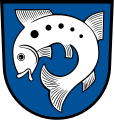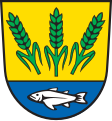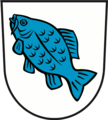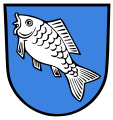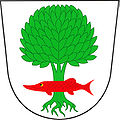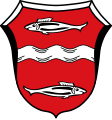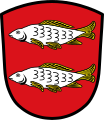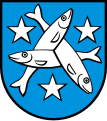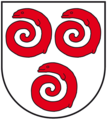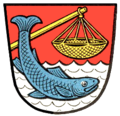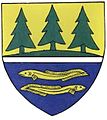Fish (heraldic animal)

The type of fish as a heraldic animal in the coat of arms is a popular common figure in heraldry .
Usage and symbolism
In heraldry, the fish as a Christian symbol refers either to Jesus Christ or to St. Peter . The fish was an early Christian symbol because of the acrostic ICHTHYS next to the staurogram - in front of the cross, which only spread in the 4th century after the Council of Nicaea (325). You can find it in numerous coats of arms.
According to the New Testament , Peter was a fisherman on the Sea of Galilee when Jesus asked him to follow him as a disciple and promised him that from now on he would be a fisherman of men.
The fish also embodies secrecy and health. There are also numerous local legends, both about size, as well as treasures found in fish or about miraculous fish (see also fisherman's Latin ).
Otherwise the fish can also be found in the coat of arms as a general symbol for fishing as a trade. The sovereignty over good fishing waters ( fish law ), like hunting law, has always been understood as a privilege.
Design and description
Based on the description ( blazon ), there is seldom a clearly identifiable fish species left on the shield or in the field. The subtle differences are not always recognizable in the light abstraction (with catfish, eel or whale it is still simple) - as always in heraldry, the decisive factor is the wording of the blazon, not the pictorial representation, which is free to the heraldist. The skin is scaled and all heraldic colors are possible.
The position of the fish in the picture is important.
- Fish are drawn horizontally, diagonally or vertically in the coat of arms: As a rule, the head is turned heraldically to the right (left of the viewer), swimming to the left , rising (head up, also pole-like, pole-appropriate ) or inverted (head down, toppled pole-wise) ).
- Two fish can be turned away or facing, intertwined (the heads placed on top of each other and the tails, alternately one on top), or crossed (at an angle , then the oblique on top, otherwise crossed to the left ), and in bars (one next to the other) or in piles (one above the other).
- Three fish in the coat of arms is also not uncommon: pole-wise, inclined or rising / upside-down, bar wise, arranged as a three-pass , star-shaped from the center of the shield or as a ring, swimming in one direction or mixed to the right and left.
Swimming only in the Schildfuß river (in the wave cut ) is not uncommon.
Winged or only bones in the arms are known - even on hooks or with a trident impaled possible. Fish-eating animals with a caught fish are particularly popular in the coat of arms: Herons with a fish in their beak or eagles with a fish in their catch should serve as an example, then the fish becomes an attribute of the predator.
The fish has also gained a place in the coat of arms . Here, as in the shield, it can be crowned and / or winged .
Special fish species
The eel is kept in the beak of a swan in Hedwigenkoog .
The barbel is a specialty . The coat of arms of the county of Barby has been a talking coat of arms since 1497 and after the assignment to Electoral Saxony in 1669 . Two blue barbels were depicted in silver with their backs to each other, floating vertically in the shield.
The gudgeon (carp fish) is the heraldic animal of the German-Baltic aristocratic family Maydell . Maidel means gudgeon in the Estonian language , today the word "rünt" is used for carp fish. The talking coat of arms of Maydell (also Maidel) shows three silver-colored gudgeons in a stream.
The pike is the heraldic animal of the Czech city of Rosice . It goes back to the coat of arms of the noble family of the Hecht von Rossitz and can also be found in the coat of arms of Litostrov as well as (crossed three times) on that of the Mainz district of Hechtsheim .
The dolphin is expected heraldic to the fish.
Examples
- location
a fish shield-filling ( Diedelsheim , DE)
im Schildfuß ( Tiefenbach , DE)
sloping fish ( Nauen , DE)
reversed tinged: ( Gunningen , DE)
in the sloping beam ( speaking : Fischingen , DE)
In the wavy band , head raised from it ( Breitenbach am Inn , AT)
placed on the trunk of a tree (pike, Litostrov , CS)
fish suitable for stake ( Lonsee , DE)
two fish counter-swimming ( Degmarn , DE)
ditto: ( Fischach , DE)
two fish facing each other ( Ruppes , FR)
facing, in mixed up colors (formerly Wernigerode district , DE)
Pair of fish (barbel) ( Saalfeld / Saale , DE)
Pair of fish (trout) ( Forchheim , DE)
Three fish ( Stekene , BE)
In the three-pass face ( Anguilla , UK)
Intertwined in a triangle (Blaubeuren- Gerhausen , DE)
Three fish crossed one above the other ( Egliswil , CH)
Three (2: 1) helical eels ( Alsleben , DE)
turned away from each other and upright ( Fischen im Allgäu , DE)
Two crossed fish ( Ängelholm , SE)
in gold a black cross brook topped with a silver fish ( Schwerzenbach , CH)
- Variations and types
crowned eel (speaking: Ahlen , DE)
Fish with daubel ( Fechenheim , DE)
(speaking: Fischbach (Taunus) , DE)
two barbel turned opposite ( Freudenstadt , DE)
Dolphins and Lilies (speaking: Dauphiné , FR)
flying fish ( Droste zu Hülshoff , DE)
winged fish ( Brokdorf , DE)
winged fish ( Mauensee , CH)
Fish with antlers ( Inari , FIN)
Fish with rope (Veržej (Wernsee) , SI)
Pike ( Rosice , CZ)
four crossed fish tails ( Simo , FIN)
Fishtail ( Vantaa , FIN)
Fish with a padlock ( Keminmaa , FIN)
crowned fish ( Baltiysk , RU)
- Combinations
Heron and fish (shield unheraldically split in two colors) ( Illmitz am Neusiedler See, AT)
Fish and lime tree ( Immenstadt im Allgäu , DE)
silver fish and deciduous tree ( Kolkwitz , DE)
Carp and bridge ( Schwarzenfeld , DE)
Fish and key as attributes of St. Petrus ( Köpenick , DE)
Eels and firs ( Amaliendorf-Ealfang , A)
Bull and Pisces ( Engels , RU)
Ship and stylized fish ( Murmansk , RU)
- Fish in the coat of arms
See also
- Whale (heraldic animal)
- Mintmaster's mark "two fish with their backs turned against each other" of the mint master Christoph Fischer (1678–1686) of the Dresden mint (see table of the mint's mint masters)
Web links
Individual evidence
- ^ Walter Leonhard : The great book of heraldic art , Callwey publishing house, Munich 1976, ISBN 3-7667-0335-8 .



